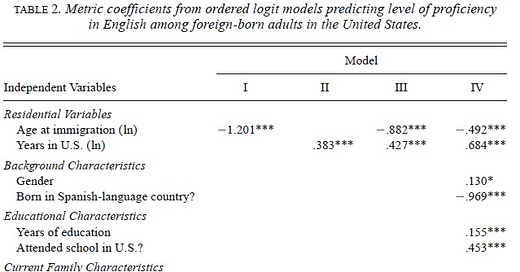Fluency, Age, and Residence
While working through the references for my non-fiction graphic novel (now titled Open Borders: The Science and Ethics of Immigration; forthcoming fall 2019), I came across a nice paper confirming our standard intuitions about language acquisition. The piece is Gillian Stevens’ “Age at Immigration and Second Language Proficiency Among Foreign-Born Adults” (Language in Society, 1999). Background:
When investigating second language (L2) acquisition among immigrants, sociologists and economists often rely on “exposure” or “human capital” frameworks, in which L2 learning is prompted by opportunities and motivations to become proficient in English. Much of this research shows that social and demographic factors, such as length of residence in the U.S. and educational attainment, strongly predict levels of proficiency in English among foreign-born adults. Linguists, by contrast, start from the premise that language acquisition is a multidimensional phenomenon to be explained through a combination of linguistic, neurolinguistic, and psycholinguistic processes. Much of their research suggests that L2 acquisition, like that of a first language (L1), is bound by maturational constraints which are tied to age at onset of language learning – typically measured through age at immigration – and which may be biologically based.
So who’s right? Both, but the linguists are more right. Stevens runs ordered logits on age of arrival, years of residence, and a few other controls. Results:

As you’d expect, age at immigration and years in U.S. have opposite signs, because arriving later impedes English acquisition, but residing longer improves it. But when you compare models I and II, age has roughly four times the effect of residence. In a simple horserace multiple regression (model III), age has roughly twice the effect of years. Note, however, that if one immigrant child immigrates a year before his twin, the earlier immigrant normally gets both benefits: arriving a year earlier, and residing for a year longer.*
Since ordered logit is non-linear, graphs are a big help. Using Model I, we see the enormous power of early arrival:

And here is the effect of years of residence, holding all else constant:

Punchline: The common-sense view that children acquire fluency with ease while adults struggle for mediocrity fits the facts. Adult immersion is far more effective than studying a foreign language in a U.S. school. But if you really want kids to learn a second language, immerse them at a young age – and keep them immersed.
* Model IV is hard to interpret; after all, better English language skills must raise your probability of marrying a native. But none of the extra variables in Model IV matter more than simply arriving (and living) one year earlier, so it’s only a mild problem.
The post appeared first on Econlib.



